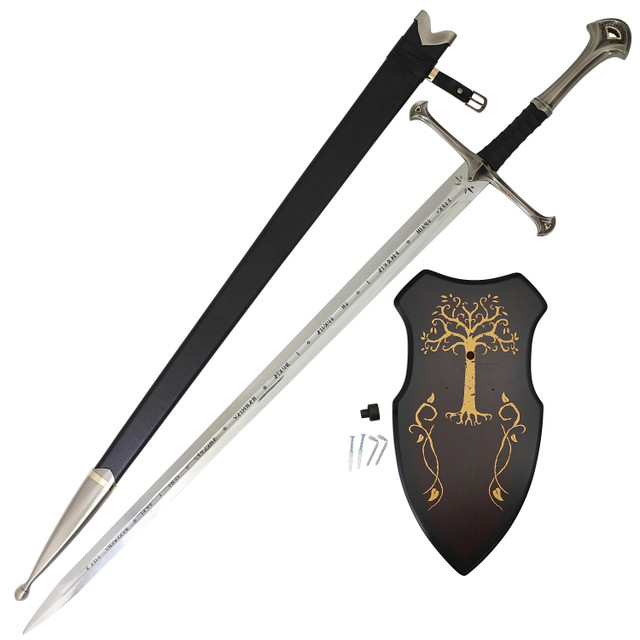Preserving Medieval Swords: Tips for Maintenance and Care
Posted by SwordsSwords on Aug 20th 2024
Medieval swords are not just historical artifacts; they are impressive pieces of craftsmanship and history. Whether you own an authentic medieval blade or a medieval sword replica, proper care and maintenance are crucial to preserving its condition and ensuring it lasts for generations. Here’s a practical guide to help you maintain and care for your medieval swords, whether they're actual historical pieces or high-quality medieval swords for sale.
Cleaning Your Medieval Sword
1. Regular Dusting
Dust is a common enemy of medieval swords. Even if your sword is on display, it can gather dust, which may eventually lead to tarnishing. Use a soft, dry cloth to regularly dust your sword, focusing on both the blade and the hilt. For medieval sword replicas, this step is especially important to prevent the buildup of grime that can tarnish the finish.

2. Removing Rust and Tarnish
If you notice rust or tarnish on your medieval sword, it’s essential to address it promptly. For minor rust spots, use a fine steel wool pad or a rust eraser, applying gentle pressure to avoid scratching the blade. Clean the affected area with a cloth lightly dampened with rubbing alcohol, then dry thoroughly. For stubborn rust, professional cleaning may be required to avoid damage.
3. Oiling the Blade
Applying a thin layer of oil helps to protect the blade from moisture and rust. Use a light mineral oil or gun oil, which works well for most medieval swords. Apply a small amount of oil to a soft cloth and rub it evenly across the blade. This will create a protective barrier that prevents moisture from causing rust. If you have a medieval sword replica, be sure to use an appropriate oil that won’t affect the finish or materials of the sword.
Storing Your Medieval Sword
1. Choose the Right Environment
Humidity is a major threat to medieval swords. Store your sword in a dry environment with controlled humidity levels to prevent rust and corrosion. Avoid placing it in damp areas like basements or attics. For added protection, consider using a dehumidifier in the storage room if you live in a particularly humid climate.
2. Use a Proper Sheath
Storing your sword in a medieval sword sheath can help protect it from dust and damage. However, leather sheaths can retain moisture, so it’s better to use a wooden or fabric-lined scabbard. Make sure the sheath is clean and dry before placing the sword inside. Avoid storing your sword in a tight-fitting sheath, as this can cause the blade to become scratched or dulled over time.
3. Display Considerations
If you choose to display your medieval swords, use a sword stand or wall mount designed to hold the blade securely and safely. Ensure that the sword is not exposed to direct sunlight, as UV rays can damage the blade and hilt. A display case with glass or acrylic can offer additional protection against dust and environmental factors.

Preserving Your Medieval Sword
1. Avoid Excessive Handling
Frequent handling of your sword can lead to wear and tear. Every time you touch the blade, you leave behind oils and dirt that can contribute to corrosion. Handle your sword only when necessary and always clean it afterward. When displaying your sword, use gloves to prevent oils from your skin from coming into contact with the blade.
2. Perform Regular Inspections
Regular inspections are key to catching any issues early. Check your sword for any signs of rust, loose parts, or damage. Pay attention to the blade, guard, and hilt. If you notice any problems, address them immediately to prevent further deterioration.
3. Proper Storage After Use
After using your sword, it’s important to clean and dry it thoroughly before storing it. Even if the sword hasn’t come into contact with water, moisture from the environment can settle on the blade. Dry the sword with a clean cloth, apply a fresh layer of oil, and store it in its sheath or display case.
4. Professional Maintenance
For significant issues like deep rust, structural damage, or if you need to restore a sword to its former glory, it’s best to consult a professional. Swordsmiths and restorers have the expertise to handle delicate repairs and maintenance, ensuring your sword remains in excellent condition.
Conclusion
Preserving your medieval swords requires attention to detail and regular care. By following these practical maintenance tips, you can keep your sword in excellent condition and ensure it remains a valuable part of your collection. Proper cleaning, thoughtful storage, and careful handling will protect your investment and honor the craftsmanship of these historic blades.
If you're looking to expand your collection, check out Swordsswords.com for a variety of medieval swords for sale, including both authentic historical pieces and high-quality replicas. Explore their selection today to find the perfect addition to your collection and keep your swords in top shape.

